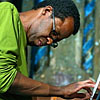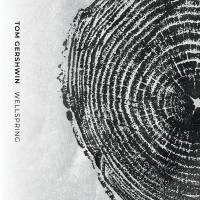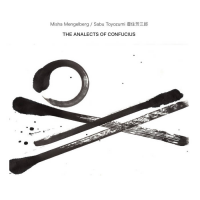Home » Jazz Articles » Album Review » Matthew Shipp: 4D
Matthew Shipp: 4D
As on Harmonic Disorder, but unlike his last two solo discs, Shipp features standards and popular songs alongside his own compositions, with some recognizable straight away but others treated so obliquely as to be unrecognizable. This allows insight to how he tackles the less well known contours of his own pieces where, unencumbered by bass and drums, Shipp takes such a free approach that it is hard to be sure whether they are extemporized or preconceived.
Although the original material won't cause an outbreak of foot-tapping, that's not the intention. There are different, more bracing pleasures to be savored. "The Crack In The Piano's Egg" is a case in point: as light refracted through a prism separates into its constituent wavelengths, so fragments of angular melody and bursts of lurching headlong rhythm, subjected to Shipp's elastic use of time, stand next to but apart from one another. "Blue Web In Space" sounds like a distant cousin of Shipp favorite "Key Swing" in its rhythmic architecture, though not in the dissonance amid the occasional blue tinged notes and ringing repetitions, while "Sequence And Vibration" often suggests it might resolve into some other Shipp compositions, but never does. At times Shipp's tactics recall other pianists: there is a touch of Sun Ra about the pealing harmonic progression of "Stairs" contrasted with quieter abstract musings, while "Primal Harmonic" has echoes of mid '70s Keith Jarrett in its low key ruminations.
Of the covers, "What Is This Thing Called Love?" is occasionally just glimpsed dashing for cover between dense stands of rhythmic crashing, while "Prelude To A Kiss" masquerades under heavy disguise. "Autumn Leaves" hews closer to the tune before an emphatic chordal mugging and a finale of stabbing Morse code supplements the accustomed cadences. "Frere Jacques" (sounding more like "Lord Of The Dance" to my ears) mutates into clanging prancing variations as if played on underwater bells, while in the closing "Greensleeves" Shipp alternates the (over)familiar theme with passages where the skies darken and thunderclouds drench this particular parade: a powerful meditation on how order descends into chaos to finish this austere but gripping disc.
Track Listing
4D; The Crack In The Piano's Egg; Equilibrium; Teleportation; Dark Matter; Stairs; Jazz Paradox; Blue Web In Space; What Is This Thing Called Love?; Autumn Leaves; Sequence And Vibration; Frere Jacques; Prelude To A Kiss; What A Friend We Have In Jesus; Primal Harmonic; Greensleeves.
Personnel
Matthew Shipp
pianoMatthew Shipp: piano.
Album information
Title: 4D | Year Released: 2010 | Record Label: Thirsty Ear Recordings
Tags
PREVIOUS / NEXT
Matthew Shipp Concerts
Support All About Jazz
 All About Jazz has been a pillar of jazz since 1995, championing it as an art form and, more importantly, supporting the musicians who make it. Our enduring commitment has made "AAJ" one of the most culturally important websites of its kind, read by hundreds of thousands of fans, musicians and industry figures every month.
All About Jazz has been a pillar of jazz since 1995, championing it as an art form and, more importantly, supporting the musicians who make it. Our enduring commitment has made "AAJ" one of the most culturally important websites of its kind, read by hundreds of thousands of fans, musicians and industry figures every month.




















